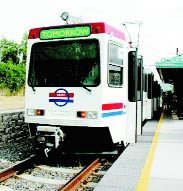Acknowledge the problem, find the solution.
by John deJong
One reason Salt Lake County Mayor Peter Corroon announced his run for governor last month was perfectly clear. What wasn’t clear were the skies. Salt Lake was experiencing what the Utah Department of Environmental Quality’s web site characterizes as “an ongoing seasonal concern.” Bureaucratese for “air that kills.” The murky soup that had sloshed up and down the Wasatch Front for the last six weeks (winning national awards for Best in Smog) was thin around the old South High and the crowd of party faithful. One could see eight or nine blocks. LOL. Rather, WOL—Wheezing Out Loud. I was worried for a couple of old hands who probably didn’t need to be outdoors breathing in January Utah air. 
But the air over South High wasn’t nearly as opaque as the cloud of smog Utah’s director of Air Quality enshrouded a Tribune reporter with a couple of weeks earlier—in an oft-repeated story about Utah’s resistance to the truth. As Utah’s environmental quality bureaucrats struggled to comply with weak new air quality standards for ozone “promulgated” by the outgoing Bush administration, they were blind-sided like a truck out of a smog bank by Obama EPA administrator Lisa Jackson’s announcement that the EPA was considering lowering the limits on ozone even further. Instead of 75 parts per billion (ppb) they will have to shoot for 70-60 ppb. Most counties along the Wasatch Front struggle with the current standard of 84 ppb. Comparable European standards are 32.5 ppb and the “no effect” level is believed to be 20ppb. Ozone is the primary constituent of the photo-chemical fog we experience during our summers, which irritates lungs and eyes.
After pointing fingers at wildfires in California and ship docks in Los Angeles as sources of ozone while studiously avoiding “our sources of pollution,” or what to do about them, the air quality director summed up the situation thus: “We have to target each one of these (ozone factors) and not point fingers. We all have our sources of pollution, but it’s everywhere.” The Utah Manufacturers Association’s spokesman’s remarks, quoted by the reporter, only added to the smog. “We just want to make sure that everyone does their part.”
That’s great. But all of the rest of us don’t profit by polluting.
All the whining about ozone transport obscures the fact that dangerous levels of ozone are dangerous no matter where they come from and that humans, much less corporations, have no “right” to inflict any higher levels on the rest of the population.
What needs to be done? Get out there and help elect a governor who believes pollution is a problem and has solutions. Drive a lot less. That means supporting more mass transit, and using what we have as best we can. That means not building another parking lot in the state if the money could go towards transit. That means achieving “European” levels of transit ridership and standards. That means complete transit solutions for large numbers of the population, not the piecemeal approach.
John deJong is associate publisher of CATALYST.
